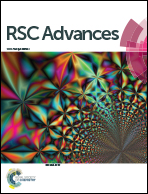Environmentally benign enhanced hydrogen production via lethal H2S under natural sunlight using hierarchical nanostructured bismuth sulfide†
Abstract
Nanorods and hierarchical nanostructures (dandelion flowers) of bismuth sulfide (Bi2S3) were synthesized using a solvothermal method. The effects of solvents such as water and ethylene glycol on the morphology and size of the Bi2S3 nanostructures were studied. A structural study showed an orthorhombic phase of Bi2S3. We observed nanorods 30–50 nm in diameter and dandelion flowers assembled with these nanorods. A formation mechanism for the hierarchical nanostructures of Bi2S3 is proposed. Based on the tuneable band gap of these nanostructures in the visible and near-IR regions, we demonstrated the photocatalytic production of hydrogen from H2S under normal sunlight. Abundantly available toxic H2S was used to produce hydrogen under normal sunlight conditions. We observed an excellent hydrogen production of 8.88 mmol g−1 h−1 under sunlight (on a sunny day between 11.30 am and 2.30 pm) for the Bi2S3 flowers and 7.08 mmol g−1 h−1 for the nanorods. The hierarchical nanostructures suppress charge carrier recombination as a result of defects, which is ultimately responsible for the higher activity. The evolution of the hydrogen obtained is fairly stable when the catalyst is used repeatedly. The evolution of hydrogen via water splitting was observed to be lower than that via H2S splitting. Bi2S3 was observed to be a good eco-friendly photocatalyst active under natural sunlight. The photo-response study showed that the Bi2S3 microstructures are good candidates for applications in highly sensitive photo-detectors and photo-electronic switches.


 Please wait while we load your content...
Please wait while we load your content...